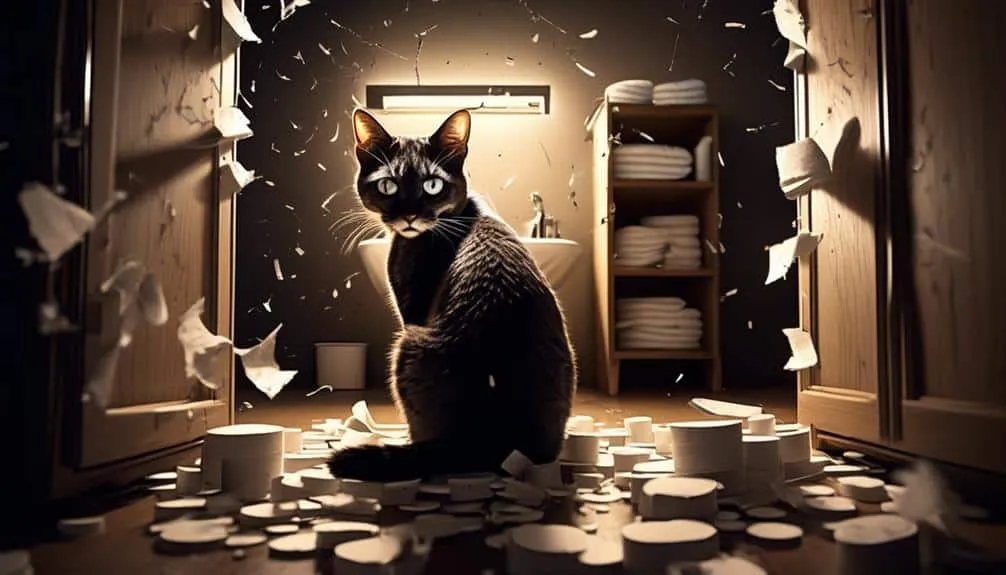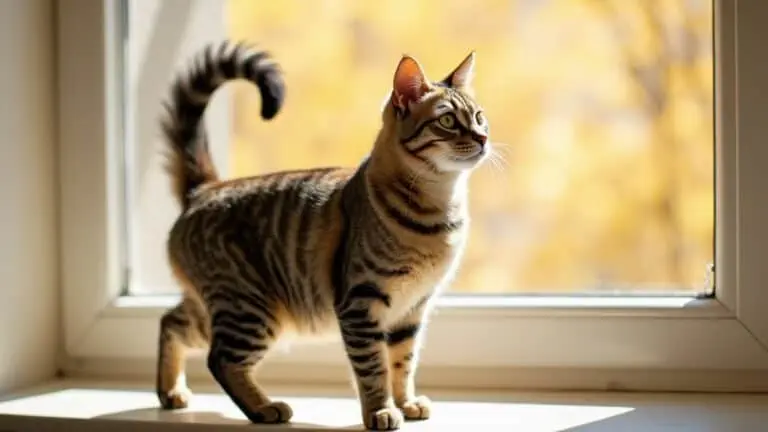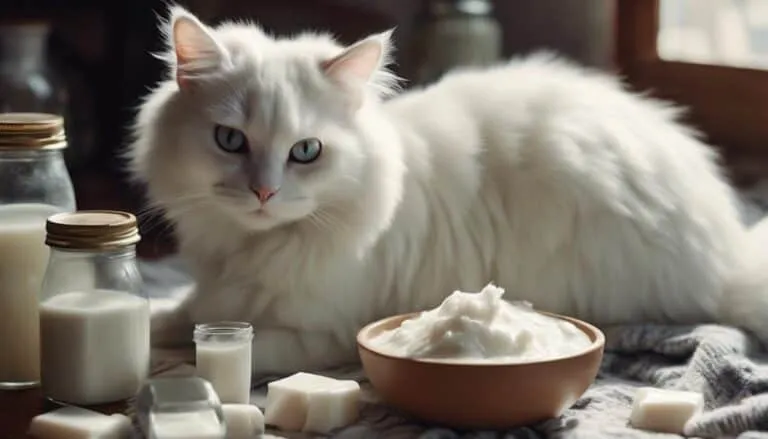The Best Fluffy Pancakes recipe you will fall in love with. Full of tips and tricks to help you make the best pancakes.

Step into the bathroom, where your feline companion transforms into an enigmatic detective, leaving behind a trail of intriguing behaviors and unanswered questions.
As you cautiously enter this mysterious realm, you can't help but wonder what secrets lie behind their fascination with sinks, showers, and the confines of their litterbox.
With each peculiar habit, your curiosity grows, urging you to uncover the hidden motivations behind their bathroom antics.
Prepare yourself for a captivating journey into the curious cat chronicles, where the depths of their mysterious bathroom habits await your discovery.
Key Takeaways
- Bathrooms provide interesting stimuli for cats, such as cool tiles, intriguing smells, and running water during showers.
- Cats value their privacy when using the litterbox and may wait until they feel safe and undisturbed.
- Cats seek out hiding spots in the bathroom, especially during times of change or when guests are present.
- Cats exhibit attention-seeking behaviors in the bathroom, such as following their owners, staring at them in the shower, or requesting interaction.
Curiosity in the Bathroom
When it comes to curiosity in the bathroom, cats can't resist exploring the cool tiles, intriguing smells, and running water that capture their interest.
Cats are naturally drawn to the bathroom environment, particularly the smooth and cool tiles that provide a refreshing surface for them to lie on and cool down. The bathroom also holds a variety of beauty products with enticing smells that pique their curiosity. From scented soaps to fragrant shampoos, cats are intrigued by these captivating scents.
Additionally, the sound and movement of running water during a shower can captivate cats, as they're instinctively curious about the source of the sound. Exploring the bathroom tiles and being intrigued by beauty products' smells are common behaviors that reflect a cat's innate curiosity and desire to investigate their surroundings.
Privacy and Litterbox Behavior
Cats exhibit a preference for privacy when it comes to their bathroom behavior. Understanding their need for privacy can help ensure their comfort and well-being.
When it comes to litterbox hygiene, it's important to keep the litterbox clean and odor-free. Scooping the box regularly and changing the litter as needed can help maintain a pleasant environment for your cat. Additionally, providing multiple litterboxes in different areas of the house can give your cat options and increase their sense of privacy.
It's also important to pay attention to your cat's body language in the bathroom. Signs of stress or discomfort, such as excessive scratching or avoiding the litterbox, may indicate a need for attention or a potential health issue.
Hiding and Seeking a Safe Space
To provide a safe space for your cat, it's important to understand their natural instinct to seek hiding spots. Cats have an innate need for privacy and alone time, especially when they feel stressed or overwhelmed. Here are some ways they cope with changes in the home and find their safe space:
- Laundry basket hideouts: Cats often find comfort in curling up in laundry baskets filled with warm, freshly laundered clothes. The familiar scent of their owners can provide a sense of security.
- Coping with changes in the home: Cats may seek hiding spots, like the bathroom, in response to significant changes such as the arrival of guests or renovations. These changes can be stressful for cats, and they need a safe space to retreat to until they feel more secure.
- Signs of stress: Keep an eye out for excessive scratching or your cat spending extended periods sitting in the litterbox. These behaviors may indicate that your cat is feeling stressed or anxious.
- Creating a safe space: Provide your cat with a dedicated hiding spot, such as a cozy bed or a quiet room with their favorite toys. This will give them a sense of security and help them cope with changes in the home.
Understanding and respecting your cat's need for a safe space is essential for their well-being. By providing them with a peaceful retreat, you can help them navigate changes in their environment more easily.
Seeking Attention and Interaction
Seeking attention and interaction is a natural behavior for cats, as recent studies have shown their preference for engaging with humans over other activities. Cats that follow their owners around are seeking attention and forming attachments.
During shower time, cats may exhibit staring behavior as a way to show love and concern. It can be an opportunity for them to ask for pets or playtime. Shower time bonding can strengthen the bond between cats and their owners.
Cats may associate the bathroom with attention and unintentionally reinforce the behavior of staring in the shower. Understanding this can help modify the behavior if necessary.
Unintentional Positive Reinforcement and Behavior Modification
Unintentional positive reinforcement can inadvertently shape and modify a cat's behavior over time. Understanding positive reinforcement techniques can help in modifying unwanted behaviors.
Here are four ways unintentional positive reinforcement can impact your cat's behavior:
- Shower staring: If your cat stares at you while you shower and you respond by giving attention or interacting with them, they may associate the bathroom with getting your attention. This unintentionally reinforces the behavior.
- Treats in the bathroom: If you give your cat treats in the bathroom, they may start associating the bathroom with receiving treats. This can lead to them seeking out the bathroom more often.
- Reacting to unwanted behaviors: If your cat displays unwanted behaviors in the bathroom, such as scratching or knocking things over, reacting to these behaviors can unintentionally reinforce them. Your cat may continue the behavior to get your attention.
- Inconsistent reinforcement: If you sometimes reward your cat for their behavior in the bathroom, but other times ignore it, this can create confusion and inadvertently reinforce the behavior.
Frequently Asked Questions
How Can I Prevent My Cat From Scratching Excessively in the Bathroom?
To prevent your cat from scratching excessively in the bathroom, try providing alternative scratching surfaces like scratching posts. Redirect their attention with interactive toys and playtime. Keep the bathroom door closed to limit access.
Why Do Some Cats Prefer to Hide in the Bathroom When Guests Are Present?
Bathroom buddies: Exploring the reasons behind cats' fascination with the bathroom. Some cats prefer to hide in the bathroom when guests are present because it provides a safe haven and solitude during social interactions.
What Are Some Signs of Stress or Health Issues That Can Be Observed in the Bathroom Behavior of Cats?
If your cat shows excessive scratching, sits in the litterbox, or has changes in litterbox behavior, it may indicate stress or health issues. Look for these signs and address them promptly for your cat's well-being.
How Can I Discourage My Cat From Staring at Me in the Shower?
To discourage your cat from staring at you in the shower, consider using shower curtain solutions like opaque curtains or closing the bathroom door. Provide alternative activities like interactive toys or play sessions to redirect their attention elsewhere.
What Are Some Effective Ways to Modify the Behavior of a Cat Who Seeks Attention in the Bathroom?
To modify your cat's attention-seeking behavior in the bathroom, try redirecting their focus with interactive toys or treats outside the bathroom. Consistently rewarding them for positive behavior can help break the habit.
Conclusion
In conclusion, the bathroom holds a captivating allure for cats, with its cool tiles, intriguing scents, and hidden corners. It becomes a sanctuary for them on hot summer days and a safe space during times of change or when guests are present.
Cats seek attention and interaction in the bathroom, whether it's through their fascination with running water or their love for shower time. Understanding unintentional positive reinforcement can help modify their behavior and create a harmonious bathroom experience for both you and your feline friend.








